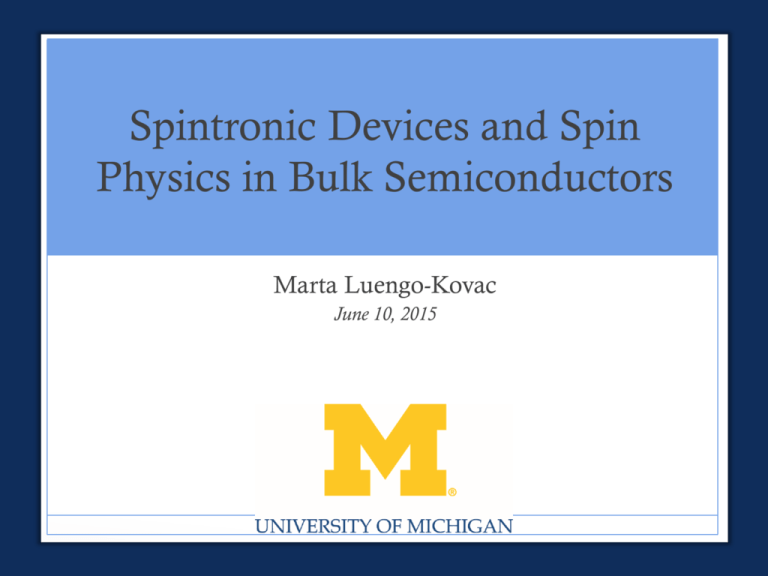Slides
advertisement

Spintronic Devices and Spin Physics in Bulk Semiconductors Marta Luengo-Kovac June 10, 2015 2 Outline • Motivation • Basic spin dynamics • Precession • Dephasing • Spin-based devices • Datta-Das Spin Modulator • Magnetic Tunnel Junctions • MRAM • My own research • Measurement techniques • Current-induced spin polarization 3 Computers - The Past • Moore’s law has held for the past 50 years • But a limit is being reached • Photolithography limit • Features smaller than the wavelength of light • Quantum limit • Tunneling causes gate leakage • Huge power dissipation • Overheating and low energy efficiency 4 Spintronics - The Future? • Why spins? • Exploit quantum features • Additional degree of freedom • Spin current doesn’t need electrical current – less power dissipation • Non-volatile – “normally off ” computers • Ando et al., J.A.P. 115, 172607 (2014) 5 What is spin? • Intrinsic angular momentum of an electron • Treat semi-classically (/) • Has magnetic moment μB • Magnetic field applies torque on magnetic moments • Can use magnetic fields to control orientation of spins B But it’s not that simple spin orbit effects • Due to spin-orbit effects – an electron moving through an electric field sees an effective magnetic field • Electrons are moving • at different speeds • in different directions • Every spin sees a slightly different magnetic field Btotal = Bexternal + Bspin-orbit GaAs crystal structure 6 7 This leads to dephasing Spin Polarization Tim e Total spin polarization Projection of S on horizontal axis Devices and their Spintronic Counterparts • Metal-Oxide-Semiconductor Field-Effect Transistor (MOSFET) • Datta-Das Spin Modulator • Dynamic Random Access Memory (DRAM) • Magnetic tunnel junctions (MTJs) • Magnetoresistive Random Access Memory (MRAM) 8 9 Metal-oxide-semiconductor field-effect transistors (MOSFETs) No current - 0 V Source n-doped p-doped Gate (off) Drain n-doped 10 Metal-oxide-semiconductor field-effect transistors (MOSFETs) Current flows - 1 V Source Gate (on) Drain ++++++++ -------n-doped p-doped n-doped 11 Datta-Das Spin Modulator Gate Source V Drain Yes measured current current No measured • Proposed: S. Datta and B. Das, Appl. Phys. Lett. 56, 665 (1990). • Demonstrated in InGaAs: Chuang, et al., Nature Nanotech. 10, 35–39 (2015). • NOT a transistor! Doesn’t amplify spin signal Dynamic Random Access Memory (DRAM) • Main type of RAM used in computers nowadays • Uses a capacitor to store a bit • Charged – 1 • Discharged – 0 • Due to capacitor discharging, must be periodically refreshed • Every 64 ms 12 13 Magnetic Tunnel Junctions Current flows - 1 Pinned Magnetic Layer V electrons tunnel Insulator Free Magnetic Layer 14 Magnetic Tunnel Junctions No current - 0 Pinned Magnetic Layer V Insulator Free Magnetic Layer Magnetoresistive Random Access Memory (MRAM) Writing (flipping the top layer): • Run current through one Bit and one Word line • Induced magnetic field only exerts enough torque to flip the magnetization where the Bit and Word lines overlap Albert Fert, Nobel Lecture; Sbiaa et al., PSS RRL 5, 413 (2011) 15 16 My Research • Optical measurements of spins • Creating a spin polarization • Measuring a spin polarization (Faraday rotation) • Measuring spin-orbit fields • Current-induced spin polarization Creating a Spin Polarization: Optical Selection Rules -1/2 m= 3 m= -3/2 1/2 1 1 -1/2 1/2 Conduction Band 3 3/2 Valence Band 17 Measuring a Spin Polarization: Faraday Rotation m= -1/2 1/2 Conduction Band m= -3/2 3/2 Valence Band 18 Measuring a Spin Polarization: Faraday Rotation • σ+ and σ - absorbed at slightly different energies • Different absorption Kramers-Kronig Relations Different index of refraction (n) • Different n for σ+ and σ - (“circular birefringence”) Angle of rotation (“Faraday angle”) Spin Polarization 19 20 Pump-Probe Setup • Pump laser pulse • Circularly polarized • Optically injects a spin polarization • Probe laser pulse • Linearly polarized • Measure Faraday rotation after transmission • Faraday rotation proportional to spin polarization 21 Pump-Probe Setup Linear Polarizer Laser Half Wave Plate Probe Wollaston Prism Pump Chopper PEM Cold Finger 22 Faraday Rotation (a.u.) Time-Resolved Faraday Rotation Faraday Rotation (a.u.) Magnetic Field Scans (Resonant Spin Amplification) J. M. Kikkawa and D.D. Awschalom, PRL 80, 4313 (1997) 23 Spatial measurements map out the spin packet 0V +2V 24 25 Fitting the spin-orbit fields All-Electrical Manipulation of Spin Polarizations • Why all-electrical? • More compatible with current computation technology • Electric fields can be applied more locally than magnetic fields • Easier to make high magnitude and high frequency electric fields than magnetic fields • Spin-orbit fields create an internal magnetic field for spin manipulation using only an applied voltage 26 All-Electrical Creation of Spin Polarizations • Why all-electrical? • Alternatives: • Laser light – complicates device design • Injection from a ferromagnet – complicates sample design • Large external magnetic field – difficult and expensive • All-electrical more compatible with current technology • Current-induced spin polarization 27 Measuring current-induced spin polarization • “CISP” • Block the pump (no optical injection of spins) • Apply an electric field • Measured spin polarization is due to the electric field 28 Measuring current-induced spin polarization Measurement Projection Axis • Current-induced: P ~ 0.1% • Optical injection: P ~ 50% 29 Understanding currentinduced spin polarization • To maximize CISP, we must understand CISP • “Common sense” explanation • CISP is due to the spin-orbit effect – coupling of an electron’s motion to its spin • Therefore, larger spin-orbit field should mean larger CISP – right? • Measurement doesn’t match theory! B. M. Norman, et al. PRL 112, 056601 (2014) 30 31 CISP device concept Bspin-orbit 1. Apply voltage to create spin polarization V 2. Apply voltage to create spin-orbit field – this manipulates the spins 3. Measure voltage through “inverse CISP” V I. Stepanov, et al. APL 104, 062406 (2014) 32 Conclusion • Spintronic devices offer several advantages, e.g. • Information density • Power consumption • Current-induced spin polarization could be used for all-electrical, all-semiconductor spintronic devices • However, we need to understand it first (no theory yet)







